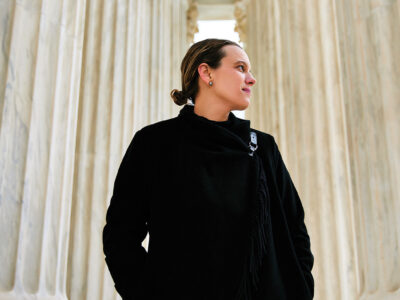
No one ever said that trying to convince teenagers to refrain from risky behavior was simple. But trying to convince large numbers of adolescents to do so through a mass-media campaign is more complicated still.
That challenge, and the high stakes involved, are among the reasons the Annenberg Public Policy Center (APPC) recently received $25 million from the Annenberg Foundation to establish a new Institute for Adolescent Risk Communication at Penn. The institute will draw on a broad range of Penn’s schools and faculty to develop and evaluate effective communications programs in four areas: tobacco use, drug use, behaviors leading to sexually transmitted diseases, and suicidal behavior.
Dr. Kathleen Hall Jamieson, dean of the Annenberg School for Communication and director of the APPC, notes that while the center has already been actively involved in evaluating and developing many of those campaigns, the new institute “will enable us to have, for the first time, an integrated focus on adolescent-risk communications that will leverage our expertise and resources for the best possible results.”
Given the nation’s heightened focus on minimizing adolescent risk, the new institute is “poised to advance research in the field and contribute to a better understanding of the issues and treatments,” said the Hon. Leonore Annenberg Hon’85, vice chairman of the Annenberg Foundation in St. David’s, Pa. In addition to the $25 million endowment, the foundation gave $2.5 million to establish a Walter and Leonore Annenberg Chair for the director of the APPC.
“Most of these campaigns, and the research accompanying them, have concentrated on reducing one risky behavior at a time,” Jamieson says. “What’s lost in this ‘single-issue’ approach is whether, for example, a successful anti-smoking campaign results in a decreased perception of the risks of drugs, or how the effectiveness of a particular campaign changes as very young teens grow older. What works for one campaign may actually be harmful to another.”
In that category would fall an anti-smoking campaign designed by Tobacco Free Kids known as “Kick Butt Day.” It’s punchy; it’s feisty; it’s memorable. But, Jamieson explains:
“It runs into a problem when you go into urban neighborhoods that are running anti-violence campaigns, because essentially the ‘Kick Butt Day’ means ‘Beat the Heck out of Someone.’ The message is running counter to the anti-violence message.”
One built-in conundrum is that kids who like taking risks want to defy a campaign designed to get them to stop. The trick, says Jamieson, is to design campaigns that “invite kids to think that it is risk-taking to buck the conventional wisdom that says they ought to engage in risk-taking behavior. It’s actually a standard persuasion ploy—to harness their objection in service of your outcome.
“Some of us tend to think that we’re pretty good at looking at an ad and saying, ‘Well, this will work,’ or ‘This won’t work,’” she admits. “The reality is that we are often surprised [by what the research reveals], and we need to figure out what the theoretical underpinnings are of those regularities that we see in responses, so that you can start using them to create rather than just evaluate after creation.”
In addition to providing opportunities for undergraduate and graduate-student research in adolescent risk, the institute will host an international summit on issues surrounding adolescent risk in May. And Jamieson stresses that the institute will both benefit from and help Penn’s interdisciplinary strengths.
“We’re hoping to ensure that information from one discipline about risk migrates over to the other disciplines,” she says. “The service to the campus community is not simply going to be that we’re going to use money to increase the likelihood that we get grants across campus, but that we’re going to talk to each other about this important area so that we generate better theory more quickly to help more people—and to advance not only the interest of the discipline but the interests of adolescents in general.”




